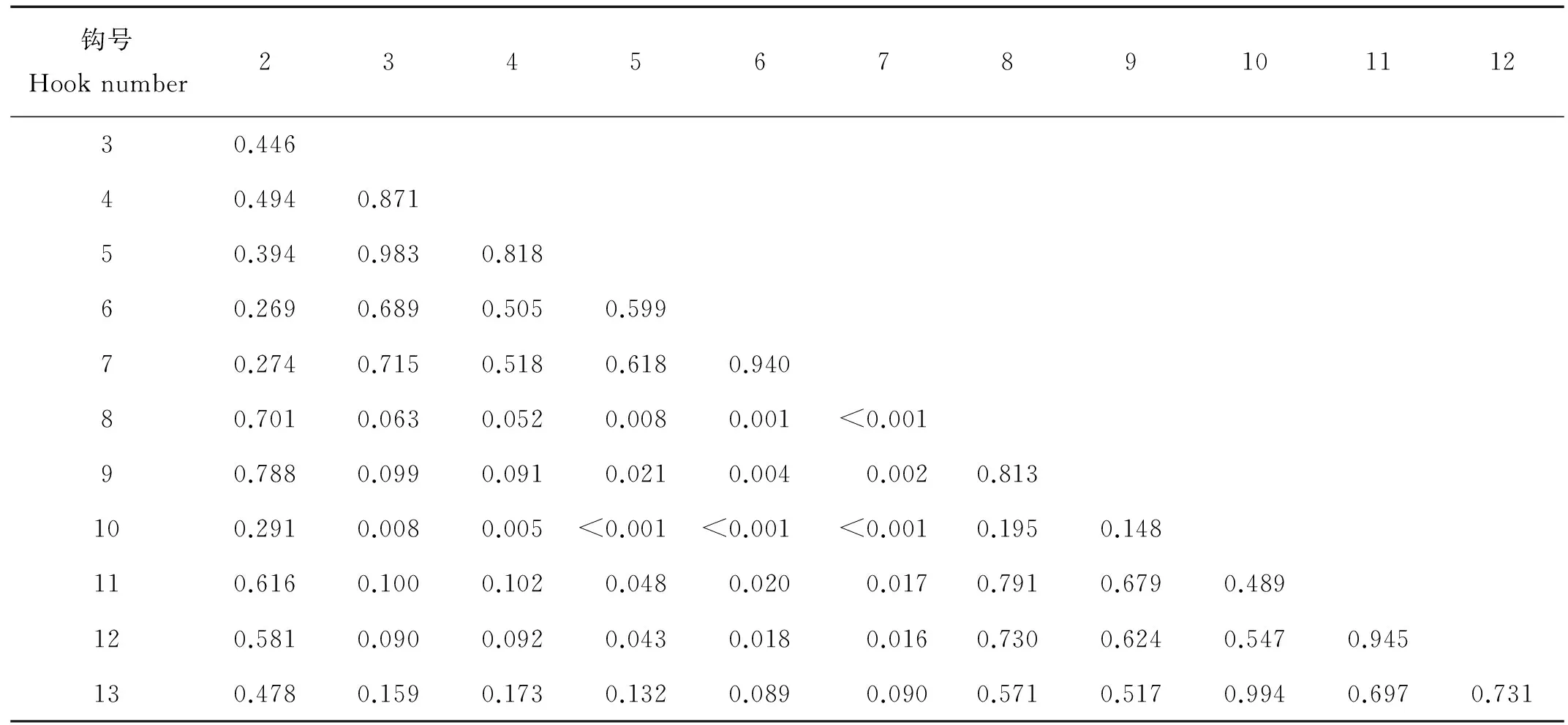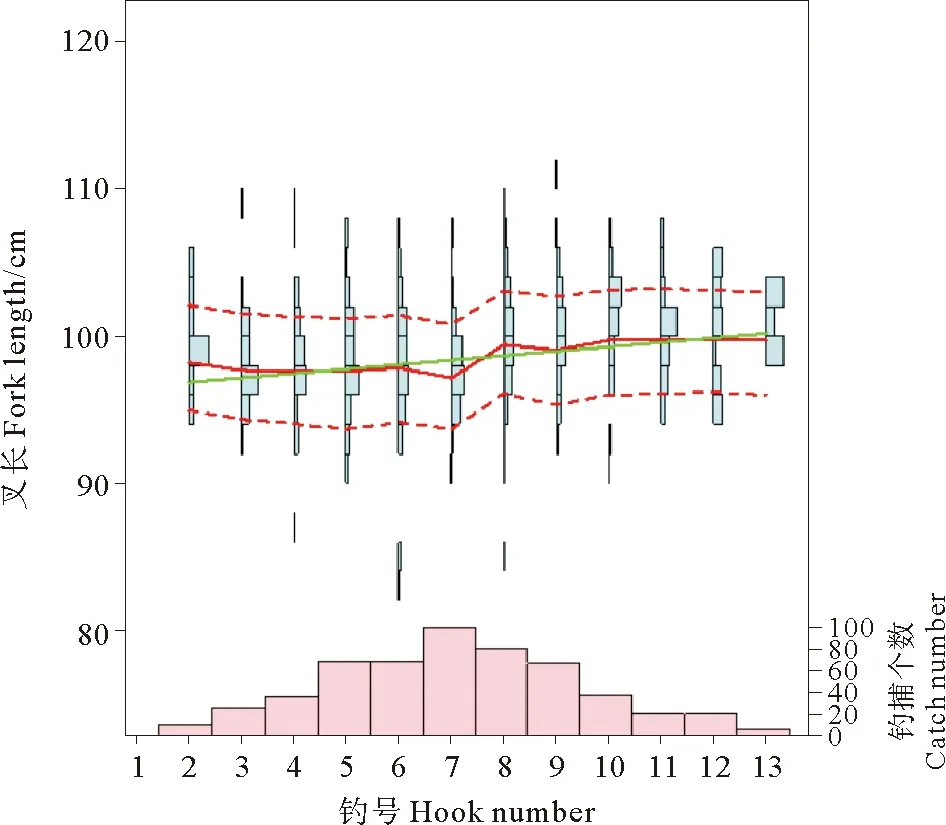钓钩深度和浸泡时间对东太平洋公海长鳍金枪鱼延绳钓渔获性能的影响研究❋
刘莉莉, 周 成, 虞聪达, 郑 基, 臧迎亮
(1. 浙江海洋大学水产学院, 浙江 舟山 316022; 2. 浙江省海洋渔业装备技术研究重点实验室, 浙江 舟山 316022; 3. 中国海洋大学水产学院, 山东 青岛 266003)
钓钩深度和浸泡时间对东太平洋公海长鳍金枪鱼延绳钓渔获性能的影响研究❋
刘莉莉1,2, 周 成3**, 虞聪达1,2, 郑 基1,2, 臧迎亮1,2
(1. 浙江海洋大学水产学院, 浙江 舟山 316022; 2. 浙江省海洋渔业装备技术研究重点实验室, 浙江 舟山 316022; 3. 中国海洋大学水产学院, 山东 青岛 266003)
为了探究金枪鱼延绳钓的钓钩深度和浸泡时间对钓捕性能和渔获特征的影响,本文基于2015年9月—2016年2月收集的东太平洋公海长鳍金枪鱼渔业调查数据,利用局部加权回归和线性回归分别拟合了钓钩深度分布与捕获的长鳍金枪鱼叉长分布的关系,统计了各钩号和叉长组的上钩渔获物的存活比例,并利用Logistic回归模型对钓钩浸泡时间与捕捞率的关系进行了统计分析。研究表明:渔获物的平均叉长随着钓钩水层的加深而略微增大,192 m(8号钩所处水层)为临界水层,该水层以浅的长鳍金枪鱼叉长明显小于该水层以深的叉长。钩号、叉长均与金枪鱼的活体比例呈较明显的相关性,这表明捕捞水层越深或鱼体越大,渔获存活率越高。以每11个连续浮球为单位计算浸泡时间,渔获率随着浸泡用时呈现波动式增长的动态响应,并在11和16 h呈现2个峰值。Logistic回归模型显示,钓钩水深对捕捞效率的影响极显著,167.57 m水深为捕捞效率密度最高的水层,若钓钩水层分布于124~211 m将有更高的捕捞效率。
金枪鱼延绳钓; 钓钩深度; 浸泡时间; 捕捞率; 渔获特征
长鳍金枪鱼(Thunnusalalunga)是高度洄游性的上层营养级海洋捕食者,也是重要的商业捕捞物种,分布于全球 50°N 和40°S之间除赤道区域附近以外的温热带海域[1-4]。2015年长鳍金枪鱼总产量达到223 013 t,占全球金枪鱼和类金枪鱼总捕捞量的4.6%,其中,延绳钓捕获产量占长鳍金枪鱼总产量的72%[5](FAO统计数据),近50%的捕捞量来自于太平洋海域。据中西太平洋金枪鱼委员会(WCPFC)统计,2015年太平洋长鳍金枪鱼捕捞量为102 997 t,我国大陆金枪鱼延绳钓捕捞产量约占10%。
目前,捕捞压力的持续增加正导致长鳍金枪鱼生物量的减少[6],尽管该种群未处于过度捕捞以及正在过度捕捞的状态,但为了避免生物量的进一步减少,需要降低延绳钓捕捞死亡率[7]。种群资源评估通常假设捕捞率(CPUE)为种群资源丰度的指数,但由于可捕系数(Catchability)一般不是常数,名义努力量和捕捞产量之间并没有必然的关系。捕捞率与种群生物量之间的关系也取决于可捕系数的大小。事实上,捕捞率的改变可能是由于渔具结构或者操作所导致的捕捞性能的改变,并非种群资源量发生变化所致[8-9]。因此,正确理解捕捞率和渔具效率之间的关系,对于基于渔业数据的种群资源评估和管理极其重要。对于被动且高选择性的延绳钓捕捞,钓捕率除受时空和海洋环境的影响外,还与渔具的结构、垂直水层分布和捕捞策略等因素有关,如钓捕深度、时间、饵料及浸泡时间等[10-14],彼此关系仍未被全面认识和应用。
为此,本研究本着探究金枪鱼延绳钓渔具结构和捕捞方式对渔具性能和渔获特征的内在关系出发,利用2015年9月—2016年2月东太平洋公海长鳍金枪鱼渔业生产船调查数据对不同钩深下的捕捞率、叉长分布和钓捕死亡比例,以及不同钓钩浸泡时间与捕捞率之间的关系进行统计分析,旨在探明延绳钓捕捞特性的规律,以期为提高渔获效率和渔具选择性提供重要的科学依据。
1 材料与方法
1.1 调查船、时间及海域
调查作业渔船为浙江省大洋世家股份有限公司所属的超低温金枪鱼延绳钓船“新世纪71号”,该船总长56.5 m、型宽8.5 m、型深3.65 m、总吨位634 t、主机功率735 kW。以长鳍金枪鱼为主要目标种群,作业于法属波利尼西亚塔希提岛以东的东太平洋公海。2015年9月—2016年2月期间在14°S~23°S,115°W~124°W水域内共调查49个站点(见图1)。

(A(实心圆):从投绳结束处起绳;B(实心三角):从投绳开始处起绳。右上方小图阴影部分表示该调查区域。A with filled circle indicates counter-retrieved-operation; B with filled triangle indicates forward-retrieved-operation.(In the zoom-out plot at upper right the survey area is shaded in grey.)
图1 延绳钓投放钩位置
Fig.1 Distribution of deployment locations in survey of tuna longline
1.2 渔具结构和捕捞操作
延绳钓主绳为8股尼龙单丝编织,直径5.4 mm;支线结构为自动挂扣(带附环)连接2 m直径4 mm的红色聚酯绳(PES),通过一枚箱型转环连接18 m直径1.3 mm尼龙单丝,通过一枚S型转环连接6 m直径1 mm 尼龙单丝,最后悬挂一枚圆型钩,总长26 m;浮子绳为80股编织的聚酯绳(PES),直径5.5 mm,长25 m;浮子材料为ABS注塑,直径360 mm,静浮力24.5 kg。
投绳过程中平均船速9.6 kn,投绳平均速度6 m/s,每篮配置26条支线,2支线之间的主绳长度为33 m,每次投放钓钩3 770枚。投绳起止时间通常为5:00~11:00,持续6 h;起钩起止时间通常为14:00~次日5:00,持续15 h。起钩方式包括从投绳开始处起绳(起头)和从投绳结束处起绳(起尾),起钩平均船速4.5 kn。
1.3 调查采样方法
调查记录的捕捞技术参数包括总钩数、两浮子间的钩数、出绳速度、船速、两钩间的时间间隔、投绳起始船位、投绳终止船位、航向、投绳开始时间、投绳结束时间、起绳开始时间、起绳结束时间和捕捞产量等;使用卷尺(GC-F5019,精度1.0 mm)和台秤(TGT-500,精度200 g)随机测定上钩渔获物的叉长和体重,并记录钓捕的钩号和生存状态;以每10篮为单位,记录起钩期间全部渔获物的尾数。
1.4 数据处理
1.4.1 延绳钓形态估计 在无环境(海流)影响下2个浮球之间延绳钓呈悬链线状态,对2个浮球之间悬链线对称一侧的钓钩从浅至深进行编号,假设每2个浮球之间的悬链线形状相同且在操作过程中浮球之间的距离不变,按照Yoshihara[15]提出的延绳钓理论深度计算方法预测各钓钩的布置水深和与最近浮球间的水平距离:
Dj=F+B+

(1)

(2)
式中:Dj为钓钩理论深度(m);Hj为钓钩与最近浮球之间的水平距离;F为浮子绳长度(m);B为支线长度(m);L为两浮子间主绳长度;N为每篮支线数,共26枚;θ为延绳钓主绳在浮子绳末端接合点处切线与水平方向的夹角(°),与短缩率k(2个连续浮球间的水平距离与主绳长度的比值)具有以下关系:

(3)
L=(N+1)·S;
(4)

(5)
式中:H为两相邻浮子之间的水平距离(m);S为两相邻支线间的主绳长度(m);Vs和Vb分别为投绳速度和船速(m/s)。
实际生产时,由于水流的影响,渔具形状和短缩率往往发生改变,钓钩的实际深度一般小于悬链线理论深度。通常采用上浮率(上浮深度占理论深度的百分比)表示钓钩上浮程度。在不同渔场和时间,上浮率可达11%~46%[10]。例如:太平洋中北部海域金枪鱼延绳钓的平均上浮率为35%[16];法属波利尼西亚专属经济区东北部区域的平均上浮率为19%[17];夏威夷外海区域2个不同时期的上浮率分别为46%和32%[10]。基于相似海域的估计值,本研究假设平均上浮率19%。


(6)

(7)
各单位内的钓获率(CPUE,尾/千钩)计算公式为:

(8)
式中:Ci为第i单位内的渔获数量;Ei为第i单位内的钓钩数。
1.4.3 渔获性能在时间和空间上的变化 考虑到渔获性能(鱼体大小和渔获率)在空间和时间上的动态变化可能是非线性的,应用局部加权回归拟合叉长和钩号、渔获率和浸泡时间的关系。局部加权法即取一定比例的局部数据,在这部分子集中拟合多项式回归曲线,以便观察到数据在局部展现出来的规律和趋势。
1.4.4 钩深和捕捞效率的关系 延绳钓的作业过程可看作对两浮子间不同水深钓钩的渔获进行抽样,并重复M次试验,渔获结果以捕获(表示为“1”)和未捕获(表示为“0”)的二值型分类变量表示,属于0-1响应的二项分布,因此对钩深与钓捕效率之间的关系采用连接函数为二项分布族中logit逻辑函数的Logistic回归模型表达。假设鱼群仅分布在钓钩布置的水层范围,响应变量为某深度下的捕捞效率,表示为该深度内的累积捕捞效率,如100 m深度的捕捞效率为100 m水深内所有钓钩的渔获数量占总渔获量的比例。通过该模型(表示如下)可预测捕捞成功的概率:
(9)
式中:P表示渔获效率,即某一水深内钓获的渔获数量(尾数)占总渔获数量的比例;D为钓钩深度(m);β0为截距;β1为模型回归系数,显著性水平设为0.05。
2 结果
2.1 不同钓钩的渔获物特征
延绳钓相邻两浮子的水平距离为712 m,钓钩的理论计算深度范围为78~287 m,每篮内有2枚钓钩理论上处于相同深度,如图2所示。通过上浮率修正,可获得延绳钓各钓钩的估算深度(见表1)。

表1 延绳钓各钓钩的估算深度
Note:①Hook number;②Estimated depth
调查期间总共随机抽样532尾长鳍金枪鱼,占总钓获数量的24.5%。其中,7号钩(钓钩号中位数)的捕获数量最多,达100尾, 1号钩无渔获,2号钩和13号钩分别仅钓获7尾和5尾。捕获的长鳍金枪鱼叉长83~110 cm,其中优势叉长95~105 cm,占总数的77.4%。利用多重t检验分析不同钩号上钓渔获物的叉长(见表2),结果表明2号钩和13号钩钓获的渔获物叉长与其它钩均没有明显差异(Pgt;0.1),3、4、5、6、7号钩组之间无明显差异, 8、9、10、11、12号钩组之间同样无明显差异,但2组之间任意2钩(号)钓获的长鳍金枪鱼叉长存在明显差异(Plt;0.1)。不同钩号钓获的长鳍金枪鱼的尾数(红色)及叉长频次分布(蓝色)见图3。分别使用局部加权回归(红实线)和线性回归(绿实线)拟合叉长和钩号的关系,结果表明2~7号钩钓获的长鳍金枪鱼的叉长基本接近,随着钩深的增加,钓获的长鳍金枪鱼个体大小有略微的增大,8号钩所处水层(192 m)为一个临界水层,该水层以深钓获的长鳍金枪鱼的叉长明显大于该水层以浅钓获的个体叉长。

(实线表示悬链线理论预测的主绳形态;虚线表示经过修正后的主绳形态。钓钩下方的数字表示钩号。White solid line is the configuration of mainline predicted by catenary algorithm, and white dotted line is the configuration of mainline after correction of shoaling. Ringed numbers below the hooks indicate the hook numbers.)

图2 两浮子间延绳钓钓钩垂直分布
注:显著性水平为0.1。Note:0.1 for significance level.

(分别使用局部加权回归(红实线)和线性回归(绿实线)拟合叉长和钩号的关系,红虚线表示标准差。Locally weighted regression (red line) and linear regression (blue line) are taken for interpreting the relationship between the fitted fork length and hook numbers, dotted line indicate standard deviation.)
图3 不同钩号渔获物的叉长分布(蓝色)及渔获数量(红色)
Fig.3 Fork length distribution (blue) and number of individuals (red) caught by different hooks
按钩号和叉长组统计的上钩渔获物活体比例(活体数占总数的百分比)见图4。其中,钩号与活体比例存在明显的相关性(Plt;0.05),这表明捕捞水层越深,鱼体的存活率越高。不同叉长组的存活率在叉长91 cm及以上的组别中同样表现出了较为明显的相关关系,尽管87~88.9和89~90.9两个叉长组的存活率分别为1和0,但样本数极少(分别为1和3)。因此,结果表明渔获物上钩后的活体比例随着鱼体大小的增加而增加。

图4 按钩号和叉长组统计的上钩渔获物活体比例
2.2 浸泡时间对渔获率的影响
试验期间共投放钩32次,每次投放14个单位。统计显示钓钩最长浸泡时间达1 340 min,最短117 min。试验期间共钓获长鳍金枪鱼2167尾,渔获率最高19尾/千钩,其中钓钩浸泡时间14~17 h、20~22 h和9~11 h 3个时间段渔获率较多。对单位浸泡时间(每小时)平均渔获率进行局部加权回归,结果显示,渔获率整体上随着浸泡时间的增加呈现波动式的增长,并在11和16 h呈现2个峰值,浸泡时间为9~16 h的单位数量较多(见图5)。

(红实线和虚线表示局部加权回归及其标准差,右侧色阶表示各浸泡时间下单位的数量。Red lines stand for locally weighted regression (solid) and standard deviation (dotted). On the right is color gradation indicating the numbers of unit at certain period of soaking.)
图5 渔获率在浸泡时间内的动态变化
Fig.5 Dynamic response of catch rate over period of soaking.
2.3 钓钩分布深度和渔获效率的Logistic模型
Logistic回归模型显示钓钩水深对捕捞效率的影响是极其显著的(Plt;0.05,见表3),钓钩分布水深的渔获效率分布拟合模型(钓钩分布水深的渔获效率分布)表示如下:

(10)
模型表示167.57 m水层的捕捞概率密度最大。延绳钓钩深作为有限且数量一定的离散变量,更加集中地布置在该水层上下水体范围内是更为有效的捕捞方法,因为深于或浅于该水深的钓钩,其钓捕效率都下降。如果以该最高渔获物钓捕水深(167.57m)为基准,获得80%的渔获物的钓钩深度置信区间为124 ~211 m(见图6,A和B分别表示捕捞效率的分布函数图和概率密度函数图),即钓钩布置在此水深区间内,将有更高的捕捞成功概率。

表3 Logistic回归模型参数估计Table 3 Estimates of modeled parameters by Logistic regression
Note:①Coefficients;②Estimate;③Standard deviation;④Z statistics

(红色实点为钩深对应渔获效率的观测值,蓝线为Logistic拟合曲线,阴影部分表示80%渔获率的水深范围。图A和B分别表示渔获效率的分布函数和概率密度函数。Red dots are observed catch efficiency against hook depth; blue line shows Logistic-fitted curve; shading region indicates the depth range of 80% catch efficiency. Sub-graph A and B show the distribution and probability density, respectively.)
图6 渔获效率和钩深的Logistic回归
Fig.6 Logistic regression between catch efficiency and hook depth
3 讨论
3.1 长鳍金枪鱼个体大小的垂直分布特征
金枪鱼的垂直分布特征与个体大小存在相关性,个体较小的鱼分布在较浅水层,这种现象在长鳍金枪鱼[18-22]、大眼金枪鱼(Thunnusobesus)[23-24]、黄鳍金枪鱼(Thunnusalbacares)[25-27]等的档案式标记追踪试验中均有报道。一种观点认为,金枪鱼幼鱼无法向成鱼一样能充分发挥自身热量保存的机制,因此不能下潜到更深的水层[28];而另一种观点认为,幼鱼在成长过程中食性发生了改变,成鱼往往在更深的水层进行摄食[18]。延绳钓通常捕获90~105 cm叉长范围的成年长鳍金枪鱼个体[7],本研究抽样的叉长范围为83~110 cm。鱼体大小存在随着钓钩深度增加而增大的关系,但由于体长范围较窄导致这种关系并不十分密切(见图3,对比8~13号钩与1~7号钩的叉长分布),这可能是由于本研究钓钩分布在60~230 m之间,体长更小的鱼往往栖息在表层,被捕获的概率较低。例如,Cosgrove等[20]的卫星档案标记数据显示,叉长78 cm的长鳍金枪鱼平均栖息深度为19 m,并在50 m以浅水体内垂直移动;Childers等[29]的标记放流试验认为,绝大多数时间内长鳍金枪鱼幼鱼分布在50 m以浅的混合层。然而,鱼体大小与栖息水深分布的正相关性应从渔获物上钩的昼夜时段以及捕捞区域进一步予以考证,因为金枪鱼种群通常随着昼夜交替具有“W”或“V”型的大范围垂直移动模式,即夜晚主要栖息于混合层以浅的表层暖水域,黎明时刻下潜至更深的冷水域。这种行为模式也因不同水域有显著差异,如温带水域的长鳍金枪鱼并不表现出白天下潜的行为运动模式[21]。因此,今后的研究应考虑不同捕捞区域以及渔获物钓获时间等因素对于长鳍金枪鱼个体大小垂直分布特征的影响。
3.2 捕捞率在浸泡时间内的动态响应
捕获率在浸泡时间内的动态响应是极为复杂的,Ward等[30]在分析影响捕捞率的概率事件时,考虑的因素包括饵料入水后可能滑落、可能被海洋动物捕食而发生丢失、随着时间推移引诱效果持续下降、鱼体上钩后可能咬断钓钩或者支线而逃逸、或者可能被捕食者掠食等。受各种因素的影响,先前关于浸泡时间对与捕捞率影响的研究结果差异较大。这些差异一方面来源于研究对象或研究区域的不同;另一方面则归于研究方法的进化,早期的研究结果倾向于浸泡时间对于捕捞率的不确定性[31-33]。随着更加复杂的模型和多因素分析方法的引入,能够更加深入和详细地解释两者关系[34]。本研究排除了因受鲸鱼干扰造成的产量下降的所有钩次,捕捞区域的鲨鱼丰度较低(仅7次鲨鱼捕获的投放钩次记录)并且作业区域风浪影响较小,因此上钩渔获被捕食而丢失以及饵料和上钩渔获受海流作用而丢失的可能性降低,这解释了渔获率整体上与浸泡时间的正相关性。然而,渔获率并非随着浸泡时间单调递增,而是呈现波动式地增长(11和16 h表现出两个峰值,或者,13和18 h时捕捞率显著降低)。其中,第一个峰值与宋利明等[35-36]的研究结论一致,第二个峰值则可能与捕捞时机有关,即某个自然时段目标种群因昼夜垂直移动的范围与钓钩分布范围重叠,由此造成渔获率增加,例如,有研究认为昼夜时期对渔获率有着显著的影响,如黄昏时期作业的钓钩对于捕捞率具有积极作用,而黎明时期对于捕捞率影响不大[30]。
3.3 最佳捕捞效率下的钩深分布
绳钓各钓钩捕捞概率可简单地表达为一个关系式,即单位时间的捕捞概率密度与钓钩影响鱼群的深度范围的乘积,并在浸泡时间内进行积分。假设各钓钩对鱼群的影响范围(钓钩所在的水深周围一定的垂直范围内能够吸引鱼群)和浸泡时间相同,钓钩的捕捞概率则取决于这个概率密度函数。由于金枪鱼的栖息环境偏好,导致在某一深度内分布最密集。根据Logistic统计模型,本研究认为167.57 m水层的捕捞概率密度最大。尽管长鳍金枪鱼的垂直分布范围很大,但如能将钓钩布置于捕捞对象概率密度高的水层范围内,将会获得最佳的钓捕性能。本研究选取80%捕捞效率作为一个候选捕捞策略,以最高渔获物钓捕水深(167.57 m)为基准,作业水深向上和向下延伸至区间为124~211 m的范围内无疑有更高的捕捞率。
钩位深度精确布置最常用的方法为调整短缩率、浮子绳长、支线长以及投绳的时间或距离间隔。例如,若将本研究中的钓钩更加集中地布置于124~211 m水层,需要增加浮子绳或支线的长度,并通过降低出绳速度增大短缩率。尽管钓钩深度的调整是极其方便的,然而投放钩策略的调整需要更加全面的考虑,如延绳钓总长度、钓钩分布密度、投钩数量与劳动力的匹配、作业循环的连贯性等,任何因素的调整可能会打破整个策略的“平衡”。例如,降低出绳速度会导致空间内钓钩密度的增加,钓钩之间干扰强烈或吸引力重叠(当投绳采用时间固定模式时);或者导致总投钩数的减少,努力量和劳动力没有得到有效利用(当投绳采用距离固定模式时)。
4 结论
本研究利用东太平洋公海长鳍金枪鱼渔业调查数据,拟合了钓钩深度分布与捕获的长鳍金枪鱼叉长分布的关系,统计了各钩号和叉长组的上钩渔获物的存活比例,并通过Logistic回归模型对钓捕水深和捕捞效率之间的关系进行了统计分析,研究结论如下:
(1)鱼体大小与钓钩的深度之间存在微弱的正相关,192 m(8号钩所处水层)为临界水层,该水层以浅的长鳍金枪鱼叉长明显小于该水层以深的个体;捕捞水层越深,被捕鱼体的存活率越高。
(2)钓钩浸泡时间大多集中在9~16 h,渔获率整体上随着浸泡时间的增加呈现波动式的增长,并在11和16 h时表现出2个峰值。
(3)钓钩水深对捕捞效率的影响极其显著,167.57 m水层的捕捞概率密度最大,以该水深为基准,80%的渔获物在124~211 m水深之间捕获。
[2] Williams A J, Allain V, Nicol S J, et al. Vertical behavior and diet of albacore tuna(Thunnusalalunga) vary with latitude in the South Pacific Ocean[J]. Deep-Sea Research II, 2015, 113: 154-169.
[3] Zárate V O, Babcock E A. Estimating individual growth variability in albacore(Thunnusalalunga) from the North Atlantic stock: Aging for assessment purposes[J]. Fisheries Research, 2015, 180: 54-66.
[4] Wells D, Kohin S, Teo S, et al. Age and growth of North Pacific albacore(Thunnusalalunga): Implications for stock assessment[J]. Fisheries Research, 2013, 147: 55-62.
[5] FAO. The State of World Fisheries and Aquaculture[M]. Rome: FAO, 2016.
[6] Langley A, Hampton J. Stock assessment of albacore tuna in the south Pacific Ocean[R]. //Working Paper SA-WP-3, 1st Scientific Committee meeting of the Western and Central Pacific Fisheries Commission. New Caledonia: Noumea, 2005.
[7] Harley S, Williams P, Nicol S, et al. The western and central Pacific tuna fishery: 2014 overview and status of stocks[R]. //Tuna Fisheries Assessment Report 15. New Caledonia: Noumea, 2015.
[8] Campbell R A, Young J W. Monitoring the behaviour of longline gears and the depth and time of fish capture in the Australian Eastern Tuna and Billfish Fishery[J]. Fisheries Research, 2012, 119-120: 48-65.
[9] Yokawa K, Takeuchi Y, Okazaki M, et al. Standardizations of CPUE of blue marlin and white marlin caught by Japanese longliners in the Atlantic Ocean[J]. Col. Vol. Sci. Pap. ICCAT, 2001, 53: 345-355.
[10] Boggs C H. Depth, capture time, and hooked longevity of longline-caught pelagic fish: timing bites of fish with chips[J]. Fishery Bulletin, 1992, 90: 642-658.
[11] Satoh K, Kusaga I, Takeda S, et al. Tuna long-line tests using monofilament Nylon[J]. Nippon Suisan Gakkaishi, 1990, 56(10): 1605-1609.
[12] Bigelow K A, Hampton J, Miyabe N. Application of a habitat-based model to estimate effective longline fishing effort and relative abundance of Pacific bigeye tuna(Thunnusobesus)[J]. Fisheries Oceanography, 2002, 11: 143-155.
[13] Ward P, Myers R A. Inferring the depth distribution of catchability for pelagic fishes and correcting for variations in the depth of longline fishing gear[J]. Canadian Journal of Fisheries and Aquatic Sciences, 2005, 62: 1130-1142.
[14] Takeuchi Y. Is historically available hooks-per-basket information enough to standardize actual hooks-per-basket effects on CPUE? Preliminary simulation approach[J]. ICCAT Coll Vol Sci Pap, 2001, 53: 356-364.
[15] Yoshihara T. Distribution of fishes caught by the longline -II. Vertical distribution[J]. Bulletin of the Japanese Society of Scientific Fisheries, 1951, 16: 370-374.
[16] Bigelow K A, Michael K, Musyl M K, et al. Pelagic longline gear depth and shoaling[J]. Fisheries Research, 2006, 77: 173-183.
[17] Bach P, Gaernter D, Menkes C, et al. Effects of the gear deployment strategy and current shear on pelagic longline shoaling[J]. Fisheries Research, 2009, 95: 55-64.
[19] Cosgrove R, Arregui I, Arrizablaga H, et al. Predation of pop-up satellite archival tagged albacore(Thunnusalalunga)[ J]. Fisheries Research, 2015, 162: 48-52.
[20] Cosgrove R, Arregui I, Arrizabalaga H, et al. New insights to behaviour of North Atlantic albacore tuna(Thunnusalalunga) observed with pop-up satellite archival tags[J]. Fisheries Research, 2014, 150: 89-99.
[21] Williams A J, Allain V, Nicol S, et al. Vertical behavior and diet of albacore tuna(Thunnusalalunga) vary with latitude in the South Pacific Ocean[J]. Deep-Sea Research II, 2015, 113: 154-169.
[22] 翟天晨, 戴小杰, 朱江峰, 等. 东太平洋长鳍金枪鱼个体大小与钓获深度的关系[J]. 海洋渔业, 2015, 37(1): 10-16.
Zhai Tianchen, Dai Xiaojie, Zhu Jiangfeng. Preliminary research on size difference and depth environment ofThunnusalalungain East Pacific[J]. Marine Fisheries, 2015, 37(1): 10-16.
[23] Fuller D W, Schaefer K M, Hampton J, et al. Vertical movements, behavior, and habitat of bigeye tuna(Thunnusobesus) in the equatorial central Pacific Ocean[J]. Fisheries Research, 2015, 172: 57-70.
[24] Musyl M K, Brill R W, Boggs C H, et al. Vertical movements of bigeye tuna(Thunnusobesus) associated with islands, buoys, and seamounts near the main Hawaiian Islands from archival tagging data[J]. Fisheries Oceanography, 2003, 12(3): 152-169.
[25] Dagorn L, Josse E, Bach P. Individual differences in horizontal movements of yellowfin tuna(Thunnusalbacares) in nearshore areas in French Polynesia, determined using ultrasonic telemetry[J]. Aquatic Living Resources, 2000, 13: 193-202.
[26] Schaefer K M, Fuller D W, Block B A. Movements, behavior, and habitat utilization of yellowfin tuna(Thunnusalbacares) in the Pacific Ocean off Baja California, Mexico, determined from archival tag data analyses, including unscented Kalman filtering[J]. Fisheries Research, 2011, 112: 22-37.
[27] Schaefer K M, Fuller D W, Aldana G. Movements, behavior, and habitat utilization of yellowfin tuna(Thunnusalbacares) in waters surrounding the Revillagigedo Islands Archipelago Biosphere Reserve, Mexico[J]. Fisheries Oceanography, 2014, 23(1): 65-82.
[28] Dickson K A, Johnson N M, Donley J M, et al. Ontogenetic changes in characteristics required for endothermy in juvenile black skipjack tuna(Euthynnuslineatus)[J]. Journal of Experimental Biology, 2000, 203(20): 3077-3087.
[29] Childers J, Snyser S, Kohin S. Migration and behavior of juvenile North Pacific albacore(Thunnusalalunga)[J]. Fisheries Oceanography, 2011, 20(3): 157-173.
[30] Ward P, Myers R A, Blanchard W. Fish lost at sea: the effect of soak time on pelagic longline catches[J]. Fishery Bulletin, 2005, 102(1): 179-195.
[31] Løkkeborg S, Pina T. Effects of setting time, setting direction and soak time on longline catch rates[J]. Fisheries Research, 1997, 32: 213-222.
[32] Sivasubramaniam K. Relation between soaking time and catch of tunas in longline fisheries[J]. Bulletin of the Japanese Society of Scientific Fisheries, 1961, 27: 835-845.
[33] Skud B E. Factors Affecting Longline Catch and Effort: Ⅲ. Bait Loss and Competition[R]. Seattle: The International Pacific Halibut Commission Scientific Report, 1978: 64-66.
[34] Carruthers E H, Neilson J D, Smith S C. Overlooked bycatch mitigation opportunities in pelagic longline fisheries: Soak time and temperature effects on swordfish(Xiphiasgladius) and blue shark(Prionace glauca) catch[J]. Fisheries Research, 2011, 108: 112-120.
[35] 宋利明, 徐伟云, 曹道梅, 等. 金枪鱼延绳钓钓具的最适浸泡时间[J]. 中国水产科学, 2013(2): 346-350.
Song Lingming, Xu Weiyun, Cao Daomei, et al. Optimum soak time of tuna longline gear[J]. Journal of Fishery Sciences of China, 2013(2): 346-350.
[36] 宋利明, 李冬静, 刘海阳, 等. 主捕长鳍金枪鱼延绳钓钓具的最适浸泡时间[J]. 上海海洋大学学报, 2014,23(2): 290-296.
Song Lingming, Li Dongjing, Liu Haiyang, et al. Optimum soak time of pelagic longline gear targeting albacore tuna[J]. Journal of Shanghai Ocean University, 2014, 23(2): 290-296.
责任编辑 朱宝象
IdentifyingtheCatchCharacteristicsofAlbacoreTuna(Thunnusalalunga)LonglineAssociatedwiththeDepthandSoakingTimeofHooksintheHighSeasofEasternPacificOcean
LIU Li-Li1, 2, ZHOU Cheng3, YU Cong-Da1, 2, ZHENG Ji1, 2, ZANG Ying-Liang1, 2
(1. College of Fisheries, Zhejiang Ocean University, Zhoushan 316022, China; 2. Key Laboratory of Marine Fishery Equipment and Technology of Zhejiang, Zhoushan 316022, China; 3. College of Fisheries, Ocean University of China, Qingdao 266003, China)
For the intention of further understanding the fishing capability and catch characteristics associated with gear and fishing operation, this study, on the basis of tuna longline fishery-dependent data from a survey in the high seas of eastern Pacific Ocean spanning from September 2015 to February 2016, performed the locally weighted regression and linear regression of hook depths to the fork length distribution, and statistics of at-vessel survival rate grouped by hooks number and fork length, as well as the dynamic response of catch rate over the period of soaking based on a logistic regression model. The results showed that, despite a less powerful relationship, the fish size remained to increase with the hooking depth. Hook No. 8 located at a critical depth that the fork length of albacore tuna caught above this depth was significantly smaller than that bellow this depth. At-vessel survival rates showed evidently positive dependence with the hook depth and fork length. Catch rate responding to the soaking time based on eleven consecutive floats as unit to calculate exhibited a growth in fluctuation with bimodal characteristics at period of 11 and 16 h. Logistic regression model suggested a significant effect of hook depth on the catch efficiency. The water layer for the highest density of catch efficiency located at depth of 167.57 m. An alternative strategy with the hooks deploying at depth ranging from 124 to 211 m will result in a more considerable fishing efficiency.
tuna longline; hook depth; soaking time; catch rate; catch characteristics
S973.3
A
1672-5174(2018)01-040-09
10.16441/j.cnki.hdxb. 20170076
刘莉莉, 周成, 虞聪达, 等. 钓钩深度和浸泡时间对东太平洋公海长鳍金枪鱼延绳钓渔获性能的影响研究[J]. 中国海洋大学学报(自然科学版), 2018, 48(1): 40-48.
LIU Li-Li, ZHOU Cheng, YU Cong-Da, et al. Identifying the catch characteristics of albacore tuna (Thunnusalalunga) longline associated with the depth and soaking time of hooks in the high seas of eastern Pacific Ocean[J].Periodical of Ocean University of China, 2018, 48(1): 40-48.
浙江省公益技术研究社会发展项目(2016C33083);国家自然科学基金青年基金项目(41606110;41506151);浙江省自然科学基金青年基金项目(LQ14C190002);2015年东太平洋公海金枪鱼资源探捕项目资助
Supported by Social Development Project of Zhejiang Public Welfare Technology Research (2016C33083); National Natural Science Foundation (41606110; 41506151); Natural Science Foundation of Zhejiang Province (LQ14C190002); Project for High Seas of East Pacific Ocean Resources Exploration in 2015
2017-02-23;
2017-04-29
刘莉莉(1991-),女,博士,讲师。E-mail:lililiuxing@hotmail.com
❋❋ 通讯作者:E-mail:zhoucheng286@126.com

